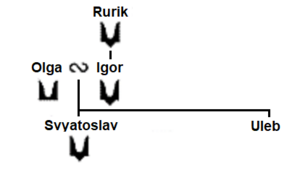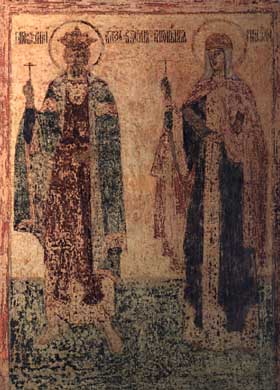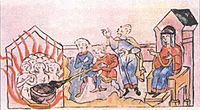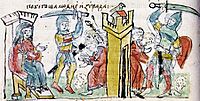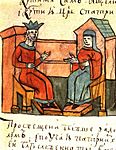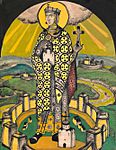Olga of Kiev facts for kids
Quick facts for kids SaintOlga of Kiev |
|
|---|---|

Saint Olga by Mikhail Nesterov
|
|
| Equal to the Apostles, Blessed Princess | |
| Born | c. 890–925 Pleskov or Vybuty, Kievan Rus' |
| Residence | Kiev, Kievan Rus' |
| Died | 11 July 969 Kiev, Kievan Rus' |
| Venerated in | Eastern Orthodoxy Roman Catholicism |
| Canonized | 1547, Moscov by Makaryev Sobors |
| Major shrine | Church of the Tithes |
| Feast | 11 July |
| Attributes | cross and church |
| Patronage | Widows, converts |
Olga (Old East Slavic: Вольга, romanized: Volĭga; Old Norse: Helga; Christian name: Elena; born around 890–925 – died 969) was a powerful ruler of Kievan Rus'. She acted as a regent (a ruler for someone too young to rule) for her son, Sviatoslav, from 945 to 960.
Olga is famous for how she got revenge on the Drevlians, a tribe that had killed her husband, Igor of Kiev. She was also very important in spreading Christianity in Kievan Rus'. Even though her grandson, Vladimir, later made Christianity the official religion, Olga's efforts earned her the title "Equal to the Apostles" in the Eastern Orthodox Church. She is honored as a saint, and her feast day is July 11.
Contents
Olga's Early Life
Birth and Marriage
We don't know exactly when Olga was born, but it was likely between 890 and 925 AD. The Primary Chronicle, an old historical record, says she was from a Viking background and was born in Pleskov. Not much is known about her life before she married Prince Igor I of Kiev.
Igor was the son of Rurik, who founded the Rurik dynasty. After Rurik died, Igor was looked after by Oleg. Oleg built up power in the region, conquering nearby tribes and making Kiev his capital. This group of tribes became known as Kievan Rus', which covered parts of what are now Russia, Ukraine, and Belarus.
The Drevlians and Igor's Death
The Drevlians were a neighboring tribe that had a complicated relationship with Kievan Rus'. They sometimes helped in wars and paid tribute (money or goods) to Igor's family. However, after Oleg died, they stopped paying tribute.
In 945, Prince Igor went to the Drevlian capital, Iskorosten, to make them pay tribute again. The Drevlians paid up when they saw Igor's large army. But as Igor was riding home, he decided he wanted more. He went back with only a small group of guards. This time, the Drevlians killed him.
Becoming a Ruler

After Igor's death in 945, Olga became the ruler of Kievan Rus'. Her son, Sviatoslav, was only three years old, so Olga ruled as his regent. She was the first woman to rule Kievan Rus'.
The Primary Chronicle tells us about how Olga took power and how she got revenge on the Drevlians for killing her husband. It also shows how she led the people of Kiev.
Olga's Revenge on the Drevlians
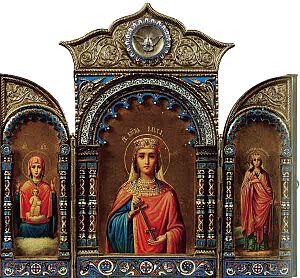
The Drevlians, feeling powerful after killing Igor, sent messengers to Olga. They suggested she marry Igor's killer, Prince Mal. Twenty Drevlian negotiators came to Kiev to deliver this message.
- First Revenge: Buried Alive
When the Drevlian messengers arrived, Olga pretended to honor them. She told them to wait in their boat, and her people would carry them into her court. The Drevlians thought this was a great honor. But instead, Olga had them carried to a trench that had been dug the day before. The Drevlian ambassadors were then buried alive in their boat. Olga reportedly watched and asked if they enjoyed the "honor."
- Second Revenge: Burned in a Bathhouse
Olga then sent another message to the Drevlians. She asked them to send their most important men to Kiev so she could go to Prince Mal with proper respect. The Drevlians, not knowing what happened to the first group, sent their best leaders. When they arrived, Olga invited them to bathe before meeting her. Once the Drevlians were in the bathhouse, Olga had it set on fire from the outside. All the Drevlians inside burned to death.
- Third Revenge: Slaughter at the Funeral Feast
Next, Olga sent a message asking the Drevlians to prepare a large amount of mead (an alcoholic drink) in the city where her husband was killed. She said she wanted to mourn at his grave and hold a funeral feast. When Olga and a small group arrived, she cried and held the feast. The Drevlians joined them. Olga then ordered her followers to kill the Drevlians. The Primary Chronicle says five thousand Drevlians were killed that night.
- Fourth Revenge: Burning of Iskorosten
After these events, Olga returned to Kiev to prepare an army to attack the remaining Drevlians. Her army won the first battle, pushing the Drevlians back into their cities. Olga then led her army to Iskorosten, the city where Igor was killed, and began a siege (surrounding a city to force surrender).
The siege lasted a year. Olga then came up with a clever plan. She sent a message to the Drevlians, asking why they were still holding out when all other cities had surrendered. She said she was no longer seeking revenge for her husband's death. She only asked for a small tribute: three pigeons and three sparrows from each house. The Drevlians were happy to end the siege for such a small price and gave her the birds.
Olga then told her soldiers to attach a piece of sulfur wrapped in cloth to each bird. At night, the soldiers lit the sulfur and released the birds. The birds flew back to their nests inside the city, setting the city ablaze. The Primary Chronicle says, "There was not a house that was not consumed." As people fled the burning city, Olga ordered her soldiers to catch them. Some were killed, and others were taken as slaves. The rest were left to pay tribute.
Olga's Governance
Olga continued to rule Kievan Rus' as regent, supported by the army and her people. She made important changes to how tribute was collected, which was the first recorded legal reform in Eastern Europe. She also defended Kiev during a siege in 968, protecting the throne for her son.
After dealing with the Drevlians, Olga traveled through their lands with her son and followers, setting up new laws and tribute rules. She created trading posts and hunting reserves across the empire. These trading centers, called pogosti, also served as administrative centers. Olga's network of pogosti helped unite the Rus' people and began to establish national borders for the kingdom.
While her son was away on long military campaigns, Olga remained in charge of Kiev.
Olga's Conversion to Christianity
Journey to Constantinople
The Primary Chronicle also tells the story of Olga's conversion to Christianity. In the 950s, Olga traveled to Constantinople, the capital of the Byzantine Empire. There, she converted to Christianity with the help of Emperor Constantine VII and the Patriarch (a high-ranking church leader).
Olga was given the Christian name "Helena," after an ancient saint. Some historians believe she was named after Emperor Constantine's wife, Helena. The Emperor was reportedly impressed by Olga and may have wanted to marry her to gain more power over Rus'. Olga asked the Emperor to baptize her, which also helped her keep her political independence.
There is some debate among historians about the exact details of her conversion. Some Russian sources say she was baptized in Constantinople in 957. However, Byzantine sources suggest she was already a Christian before her 957 visit. It's possible she was baptized in Kiev around 955 and then had a second christening in Constantinople. Olga was not the first person from Rus' to become Christian, but she was the most powerful ruler to be baptized during her lifetime.
Spreading Christianity in Rus'
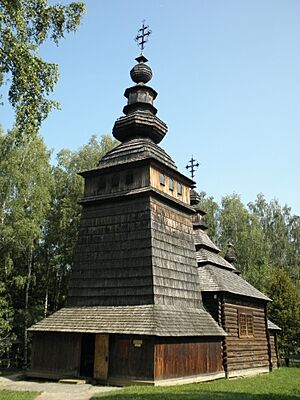
After her baptism, Olga returned home with the Patriarch's blessing. She tried to convince her son, Sviatoslav, to become Christian, but she was not successful. The Chronicle says Sviatoslav worried his followers would "laugh" at him if he accepted Christianity.
Even though Sviatoslav did not convert, he agreed not to harm those in his kingdom who did. This was an important step for Christianity in the region. Despite her people's resistance, Olga built churches in Kiev, Pskov, and other places.
Relations with the Holy Roman Emperor
In 959, Olga sent representatives to Emperor Otto I in the Holy Roman Empire. They asked the emperor to send a bishop and priests to Rus'. However, the first bishop sent, Adalbert of Magdeburg, was expelled by pagan allies of Sviatoslav.
Some historians believe that a change in power happened in Kiev between 959 and 961. The pagan group became stronger, and the young Sviatoslav pushed his mother, Olga, into the background. This might be why the German bishops had to return without success.
Olga's Death
According to the Primary Chronicle, Olga died from an illness in 969. This was soon after the Pechenegs (a nomadic tribe) had laid siege to Kiev. When Sviatoslav announced he planned to move his capital to the Danube region, the sick Olga convinced him to stay with her during her final days.
Even though Sviatoslav did not follow his mother's Christian faith, he respected her wishes. Olga asked that her priest, Gregory, perform a Christian funeral without the traditional pagan burial feast. Her tomb remained in Kiev for over two centuries but was destroyed by the Mongolian-Tatar armies in 1240.
Olga's Legacy
Sainthood
At the time of her death, it seemed Olga's efforts to make Kievan Rus' a Christian land had failed. However, her grandson, Vladimir, officially adopted Christianity in 988.
In 1547, nearly 600 years after her death, the Russian Orthodox Church named Olga a saint. Because of her strong influence in spreading Christianity, the Eastern Orthodox Church and other related churches call Olga "Isapóstolos," which means "Equal to the Apostles." Olga's feast day is July 11, the day she died. She is considered the patron saint of widows and converts.
Churches and Monuments
Many churches and monuments have been built to honor Saint Olga.
- In Ukraine:
* Cathedral of St. Olha, Kyiv (opened 2010) * Church of Sts. Olha and Elizabeth, Lviv * Many other churches named after Saints Volodymyr and Olha across the country.
- In Russia:
* Monuments of St. Olga in Pskov (2003) and Vladimir. * The Olga bridge and St. Olga's chapel in Pskov. * Princess Olga Airport in Pskov. * St. Olga is on the Millennium of Russia monument in Veliky Novgorod. * Several St. Olga cathedrals in Moscow.
- Around the World:
* Sts. Volodymyr and Olha Ukrainian Catholic Church, Chicago, United States. * Saints Vladimir and Olga Ukrainian Catholic Cathedral and Parish Hall, Winnipeg, Manitoba, Canada. * Saints Volodymyr and Olha Church, Woodville, South Australia, Australia.
Arts and Literature
In 1981, a new ballet based on Olga's life was created to celebrate the 1500th anniversary of the city of Kyiv.
Gallery
- Illuminations from the Radziwiłł Chronicle
-
Fourth revenge of Olga: Burning of Derevlian capital Iskorosten
- Portraits
-
Nicholas Roerich's Saint Olga (1915)
See also
 In Spanish: Olga de Kiev para niños
In Spanish: Olga de Kiev para niños
- Princess Olga Pskov Airport
- Order of Princess Olga (established in Ukraine in 1997)
- Olga Bay and Olga, Russia
- Christianization of Kievan Rus'
- A Perfect Absolution - concept album by French band Gorod about Olga of Kiev


